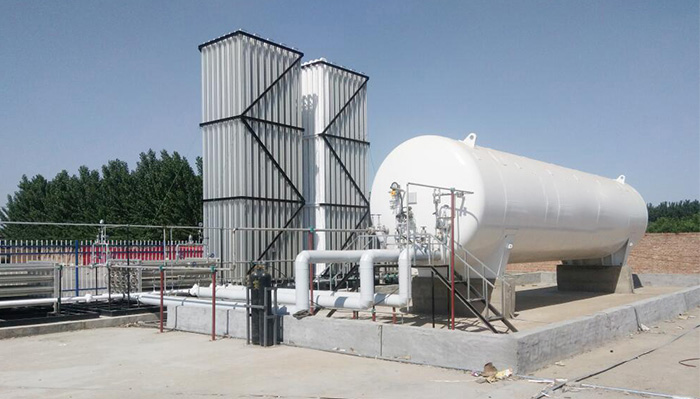Product Category
LNG gasification station unloading method
Date: Nov 08, 2019

The LNG gasification station is a receiving, storage and distribution LNG satellite station. It is also an intermediate adjustment place for towns or gas companies to transfer LNG from the manufacturer to the user. It can be used together with LNG cryogenic storage tanks. With its short construction period and the ability to quickly meet the demand of the gas market, LNG gasification station has gradually been built in many small and medium-sized cities with developed and energy-stricken cities in various countries, and has become a transitional gas supply before the arrival of gas supply facilities or natural gas. facility. LNG has become the main gas source or transition gas source for cities that cannot use natural gas for gas supply, and is also a supplementary gas source or peak-regulating gas source for many cities that use natural gas for gas supply.
LNG gasification station unloading process:
LNG is transported from the LNG liquefaction plant to the LNG gasification station in the gas city by road tanker or tank container truck, and the tank tank is boosted by the air temperature booster gasifier on the tanker (or through the unloading station set in the station) The pressurized gasifier boosts the tank container truck to form a certain pressure difference between the tank truck and the LNG storage tank, and the pressure difference is used to discharge the LNG in the tank truck into the gasification station storage tank. At the end of the unloading, the gas phase natural gas in the tank truck is recovered through the unloading station gas phase pipeline.
When unloading the truck, in order to prevent the pressure in the LNG storage tank from rising, the speed of the unloading is affected. When the temperature of the LNG in the tanker is lower than the temperature of the LNG in the tank, the upper inlet method is adopted. The low-temperature LNG in the tank truck enters the storage tank through the inlet nozzle of the storage tank in a spray state, and the partial gas is cooled to a liquid to reduce the pressure inside the tank, so that the unloading can be smoothly performed. If the LNG temperature in the tanker is higher than the temperature of the LNG in the tank, the lower inlet method is adopted, and the high-temperature LNG enters the storage tank from the lower inlet port, and is mixed with the low-temperature LNG in the tank to cool down, thereby avoiding the high-temperature LNG from the upper inlet port. Evaporation into the tank and increased pressure in the tank result in difficulty in unloading the truck. In actual operation, since the current LNG gas source is far away from the gas city, when the long-distance transportation reaches the gas city, the LNG temperature in the tanker is usually higher than the temperature of the LNG in the gasification tank, and only the lower liquid can be used. the way. Therefore, in addition to the use of the upper liquid filling method when filling the LNG for the first time, the normal unloading method basically adopts the lower liquid feeding mode.
In order to prevent the sudden temperature change during unloading, the large temperature difference stress damages the pipeline or affects the unloading speed. Before each unloading, the unloading pipeline should be pre-cooled with the LNG in the storage tank. At the same time, it should be prevented from opening or closing the valve quickly so that the flow rate of the LNG suddenly changes to cause a liquid hammer to damage the pipe.
Henan Jianshen Metal Materials Co., Ltd. produces a series of accessories for LNG storage tanks, including vaporizers, cryogenic pumps, filling systems, pressure regulating devices, etc., to meet the different needs of customers.
LNG gasification station unloading process:
LNG is transported from the LNG liquefaction plant to the LNG gasification station in the gas city by road tanker or tank container truck, and the tank tank is boosted by the air temperature booster gasifier on the tanker (or through the unloading station set in the station) The pressurized gasifier boosts the tank container truck to form a certain pressure difference between the tank truck and the LNG storage tank, and the pressure difference is used to discharge the LNG in the tank truck into the gasification station storage tank. At the end of the unloading, the gas phase natural gas in the tank truck is recovered through the unloading station gas phase pipeline.
When unloading the truck, in order to prevent the pressure in the LNG storage tank from rising, the speed of the unloading is affected. When the temperature of the LNG in the tanker is lower than the temperature of the LNG in the tank, the upper inlet method is adopted. The low-temperature LNG in the tank truck enters the storage tank through the inlet nozzle of the storage tank in a spray state, and the partial gas is cooled to a liquid to reduce the pressure inside the tank, so that the unloading can be smoothly performed. If the LNG temperature in the tanker is higher than the temperature of the LNG in the tank, the lower inlet method is adopted, and the high-temperature LNG enters the storage tank from the lower inlet port, and is mixed with the low-temperature LNG in the tank to cool down, thereby avoiding the high-temperature LNG from the upper inlet port. Evaporation into the tank and increased pressure in the tank result in difficulty in unloading the truck. In actual operation, since the current LNG gas source is far away from the gas city, when the long-distance transportation reaches the gas city, the LNG temperature in the tanker is usually higher than the temperature of the LNG in the gasification tank, and only the lower liquid can be used. the way. Therefore, in addition to the use of the upper liquid filling method when filling the LNG for the first time, the normal unloading method basically adopts the lower liquid feeding mode.
In order to prevent the sudden temperature change during unloading, the large temperature difference stress damages the pipeline or affects the unloading speed. Before each unloading, the unloading pipeline should be pre-cooled with the LNG in the storage tank. At the same time, it should be prevented from opening or closing the valve quickly so that the flow rate of the LNG suddenly changes to cause a liquid hammer to damage the pipe.
Henan Jianshen Metal Materials Co., Ltd. produces a series of accessories for LNG storage tanks, including vaporizers, cryogenic pumps, filling systems, pressure regulating devices, etc., to meet the different needs of customers.
Send Your Inquiry
We not only provide a good product, but also provide high quality service. If you are interested in our products,
you can contact us in the following ways.
you can contact us in the following ways.







